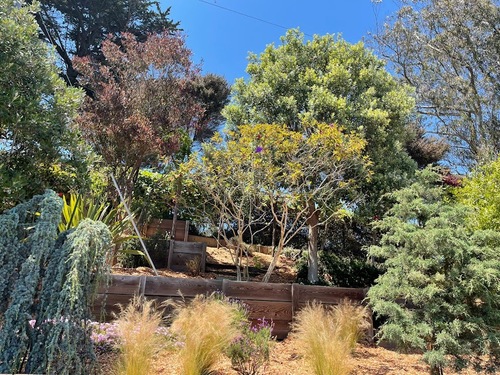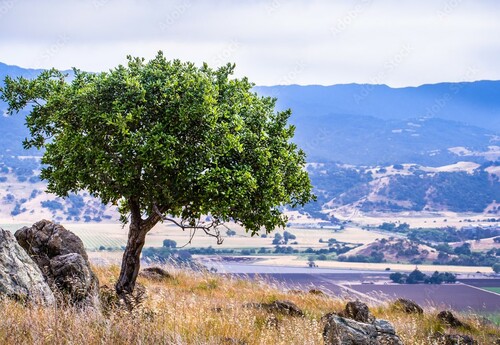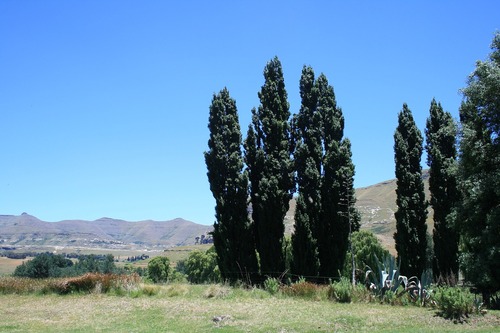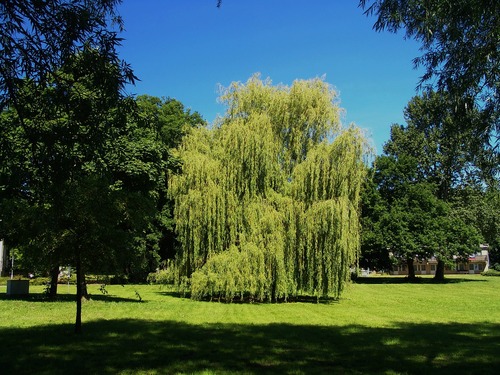Tree Shapes: Pyramids, Lollipops, and Vases
Introduction
Welcome to a comprehensive exploration of the world of trees and their diverse shapes, where aesthetics meets practicality. In this extensive guide, we move beyond surface beauty to delve into the essential reasons why tree shapes matter. Beyond the appeal of blossoms and foliage, the shapes of tree crowns reveal stories of resilience, adaptation, and the delicate balance between nature and nurture.
Unraveling Tree Shapes

Blooming Trees Planted Above a Retaining Wall
Variety Beyond Seven Shapes
While most botanists categorize trees into seven basic shapes, there is certainly room for variation. Some authorities recognize more or fewer shapes, highlighting the nuanced variations contributing to the vibrancy of outdoor spaces. Each shape represents the adaptability and uniqueness of the tree, painting a picture of botanical diversity that is captivating and essential for ecological balance.
Nature’s Artistry: Outliers and Pruning Prowess
Just as every artist creates masterpieces with individual flair, trees showcase their uniqueness. Nature’s outliers, shaped by genetics and environment, create living sculptures that stand out amidst the crowd. Skilled pruning practices emerge as a form of art, allowing us to sculpt trees into specialized shapes, adding a touch of human creativity to the canvas of nature.
Exploring Tree Shapes
Embarking on a journey through the diverse world of tree shapes opens a portal to the varied landscapes they can create. Each shape not only contributes to the visual tapestry but also serves a functional purpose, influencing the microenvironment it inhabits.
Round: Simple Symmetry

A Round-Crowned Tree Juts Out from a Hillside
Round-crowned trees, like white oaks and European lindens, bring simple symmetry to your landscape. Imagine a cluster of round trees framing your property, offering a harmonious and timeless scene. This shape is quite prevalent in landscaping.
Varieties:
- White Oaks ( Quercus alba )
- European Lindens ( Tilia europaea )
- Paperbark Maples ( Acer griseum )
Consider planting a mix of white oaks and paperbark maples for a dynamic display. The white oak’s sturdy branches provide excellent shade, while the paperbark maple’s distinctive peeling bark adds texture and visual interest.
Oval: Subtle Elegance
Admittedly, the difference between a tree with a round crown and one with an oval crown can be subtle, but at the extreme ends of the spectrum, the differences are obvious. Oval-crowned trees, like downy serviceberries and sugar maples , bring subtle elegance to your landscape. Picture a pathway lined with these gracefully elongated trees, creating a sense of flow and continuity in your garden.
Varieties:
- Downy Serviceberries ( Amelanchier arborea )
- Sugar Maples ( Acer saccharum )
- Frontier Elms ( Ulmus ‘Frontier’ )
Create a charming entryway by combining sugar maples with frontier elms. The vibrant fall foliage of the sugar maple pairs beautifully with the frontier elm’s arching branches, creating a warm welcome.
Columnar: Vertical Majesty

Columnar Arborvitaes Create a Striking Contrast with the Landscape
Columnar trees, like Lombardy poplars and emerald arborvitaes, offer vertical accents for privacy screens. Their tall, narrow crowns transform your outdoor space into a private sanctuary.
Varieties:
- Lombardy Poplars ( Populus niger ‘Italica’ )
- Red Cedars ( Juniperus virginianus )
- Emerald Arborvitaes ( Thuja occidentalis ‘Emerald’ )
Create an elegant boundary with a row of emerald arborvitaes . Their vibrant foliage and compact form make them an ideal choice for a living fence, providing both beauty and functionality.
Spreading: Horizontal Grandeur
Spreading trees, like live oaks , expand horizontally to create a natural canopy. These trees provide visual expanse, creating a tranquil outdoor space.
Varieties:
- Live Oaks ( Quercus virginiana )
- London Plane Trees ( Platanus x acerifolia )
Enhance the visual impact of your lawn by combining the spreading branches of live oaks with the distinctive bark of London plane trees. This dynamic duo creates a picturesque setting, offering shade and texture.
Vase-Like: Elegance Meets Functionality

Vase-like Crape Myrtles Line a Residential Street
The vertical branches of some trees tend to fall outward, giving the crown a vase-like appearance. Vase-like trees, like American elms and ‘Green Vase’ zelkovas, offer shade while maintaining a low profile. These trees preserve sight lines and enhance the functionality of your outdoor space.
Varieties:
- American Elms ( Ulmus americana )
- Green Vase Zelkovas ( Zelkova serrata ‘Green Vase’ )
- Crape Myrtles ( Lagerstroemia spp. )
For a burst of color, plant a mix of American elms and crape myrtles. The crape myrtle’s summer blooms complement the American elm’s graceful vase-like form, creating a stunning focal point.
Pyramidal: Nature’s Geometry
Pyramidal trees, like blue spruces and Leyland cypresses , add drama and sophistication. Their crowns, widest at the bottom and tapering to a fine point, create a visually arresting contrast.
Varieties:
- Blue Spruces ( Picea pungens )
- Deodar Cedars ( Cedrus deodara )
- Leyland Cypresses ( Cupressus x leylandii )
Transform your backyard into a sanctuary of serenity by planting a combination of blue spruces and Leyland cypresses. The blue spruce’s silvery-blue needles harmonize with the Leyland cypress’s vibrant green.
Weeping: Subdued Beauty

A Lush Weeping Willow in a Healthy Green Space
Weeping trees, like weeping willows and weeping figs, add a touch of subdued beauty. Their branches gracefully cascade, creating a tranquil atmosphere in your garden.
Varieties:
- Weeping Willows ( Salix babylonica )
- Weeping Figs ( Ficus benjamina )
Enhance the charm of your water feature by planting weeping willows alongside weeping figs. The gentle cascading branches create a peaceful retreat in your garden.
The Art of Tree Selection: Practical Considerations
Choosing the right tree shape involves more than just aesthetic preferences. It requires a thoughtful consideration of your property’s layout, your goals, and the specific conditions in your region. Let’s explore some practical considerations to guide you in making informed choices.
Sun Exposure
Different tree shapes respond differently to sunlight. If you’re aiming to create shaded areas in your garden, consider trees with spreading or vase-like forms. For areas where you want more sunlight, columnar or pyramidal trees might be the ideal choice.
Space Constraints
Understanding the space available is crucial. For narrow areas, columnar trees provide height without taking up excessive ground space. In more expansive settings, spreading or round trees can create a fuller, more balanced appearance.
Maintenance Level
Consider the time and effort you’re willing to invest in maintenance. While all trees require care, some shapes may naturally lend themselves to lower maintenance needs. Columnar trees, for instance, often require less pruning than spreading varieties.
Environmental Adaptability
Ensure the trees you choose are well-suited to your local climate and soil conditions. Consult with local arborists or nurseries for guidance on tree species that thrive in your region. This ensures the long-term health and vitality of your chosen trees.
Choosing the Right Tree Shape

Low Hedges Border this Small Vase-like Tree in a Courtyard
When selecting trees for your property, consider the purpose behind your choices. Some property owners place a premium on beautiful flowers, while others prefer a tree that does not create a lot of litter. Alternatively, some are seeking to create a privacy screen around their property. Tailor your selections to align with your intentions, ensuring a cohesive and visually appealing landscape.
Pruning Dilemma: A Considered Approach
While it’s tempting to shape a tree through pruning, this approach comes with challenges and is not the wisest course of action. Pruning is labor-intensive, costly, and forces the tree to adapt to stressful circumstances. Instead, opt for a tree with a natural growth habit that aligns with your preferences.
The Benefits of Tree Diversity
Environmental Harmony
Incorporating a variety of tree shapes into your landscape contributes to environmental harmony. Diverse shapes provide habitats for different bird species, insects, and small mammals, fostering a healthy ecosystem. A biodiverse garden is visually appealing and plays a vital role in supporting local wildlife.
Seasonal Interest
Choosing trees with various shapes ensures a dynamic visual spectacle throughout the seasons. From the blossoms of spring to the vibrant foliage of fall, each tree shape adds its unique charm, creating a landscape that evolves and delights year-round.
Exploring Additional Tree Shapes: Beyond the Basics

This Urban Pine Tree Most Closely Matches Vase-like Tree Structure
While we’ve covered several recognized tree shapes, the diversity in nature extends far beyond these commonly categorized forms. Exploring further reveals a tapestry of distinctive tree shapes that bring their own charm to outdoor spaces.
Umbrella-Shaped: Canopies of Protection
Umbrella-shaped trees, such as the Chinese parasol tree ( Firmiana simplex ) and the umbrella thorn acacia ( Vachellia tortilis ), offer broad, spreading canopies resembling, as the name suggests, an open umbrella. These trees provide generous shade and create an inviting space for relaxation and shelter.
Globe-Shaped: Compact and Charming
Globe-shaped trees, like the ‘Globe’ Norway maple ( Acer platanoides ‘Globosum’ ) and ‘Globe’ blue spruce ( Picea pungens ‘Glauca Globosa’ ), grow into dense, rounded forms. Their compactness makes them ideal as ornamental specimens, adding a touch of symmetry and elegance to gardens.
Conical-Shaped: Nature’s Tapered Design
Conical trees, such as the Italian cypress ( Cupressus sempervirens ) and the Eastern white pine ( Pinus strobus ), feature a classic triangular form, tapering gently from a wider base to a pointed top. These trees create vertical accents, making them suitable for framing entrances or creating visual focal points.
Fastigiate: Towering Elegance
Fastigiate trees, like the European hornbeam ( Carpinus betulus ‘Fastigiata’ ) and the Fastigiate English oak ( Quercus robur ‘Fastigiata’ ), grow in a narrow, upright manner, often resembling tall columns. Their slender profiles make them excellent choices for avenues and narrow spaces, adding vertical interest without taking up much horizontal room.
Flat-Top: Horizontal Canopies
Flat-top trees, including the ‘Flat Top’ Japanese cedar ( Cryptomeria japonica ‘Yoshino’ ) and some varieties of the Arizona cypress ( Cupressus arizonica ), exhibit crowns that grow predominantly horizontally, creating a distinctively flat or table-like appearance. These trees offer a unique silhouette and can be used to create eye-catching contrasts in a landscape.
Twisted and Contorted: Nature’s Artistry
Twisted and contorted trees, such as the contorted filbert ( Corylus avellana ‘Contorta’ ) and the twisted willow ( Salix babylonica ‘Tortuosa’ ), grow with irregular, gnarled branches, often resembling living sculptures. Their unique shapes add an element of whimsy and intrigue to garden settings.
Multi-Trunked: Nature’s Fusion
Multi-trunked trees, like the river birch ( Betula nigra ) and the lacebark elm ( Ulmus parvifolia ), grow with multiple main trunks emerging from the ground. Their varied trunks create visual interest, lending a rustic and naturalistic feel to landscapes.
These diverse tree shapes offer a myriad of possibilities for creating unique, personalized landscapes. Incorporating these less traditional forms alongside more commonly recognized shapes can add depth, texture, and an element of surprise to your outdoor sanctuary.
Conclusion
Throughout this guide, we’ve explored the world of tree shapes, uncovering their unique roles in shaping landscapes. Beyond mere appearances, these shapes play practical roles, telling stories of adaptation and functionality.
From the simplicity of round crowns to the distinctiveness of pyramidal forms, each tree shape adds character to your outdoor space. With Arborist Now as your partner, these shapes come together, creating a balanced and purposeful landscape. Contact us today for help with choosing the right trees for your outdoor space.
Plant with intention, considering each shape’s contribution, and witness your garden thrive with natural diversity. As you navigate your landscaping journey, let these insights assist you in creating an outdoor haven where every tree shape plays a part in crafting a charming and functional environment.
Originally posted on May 25, 2016


